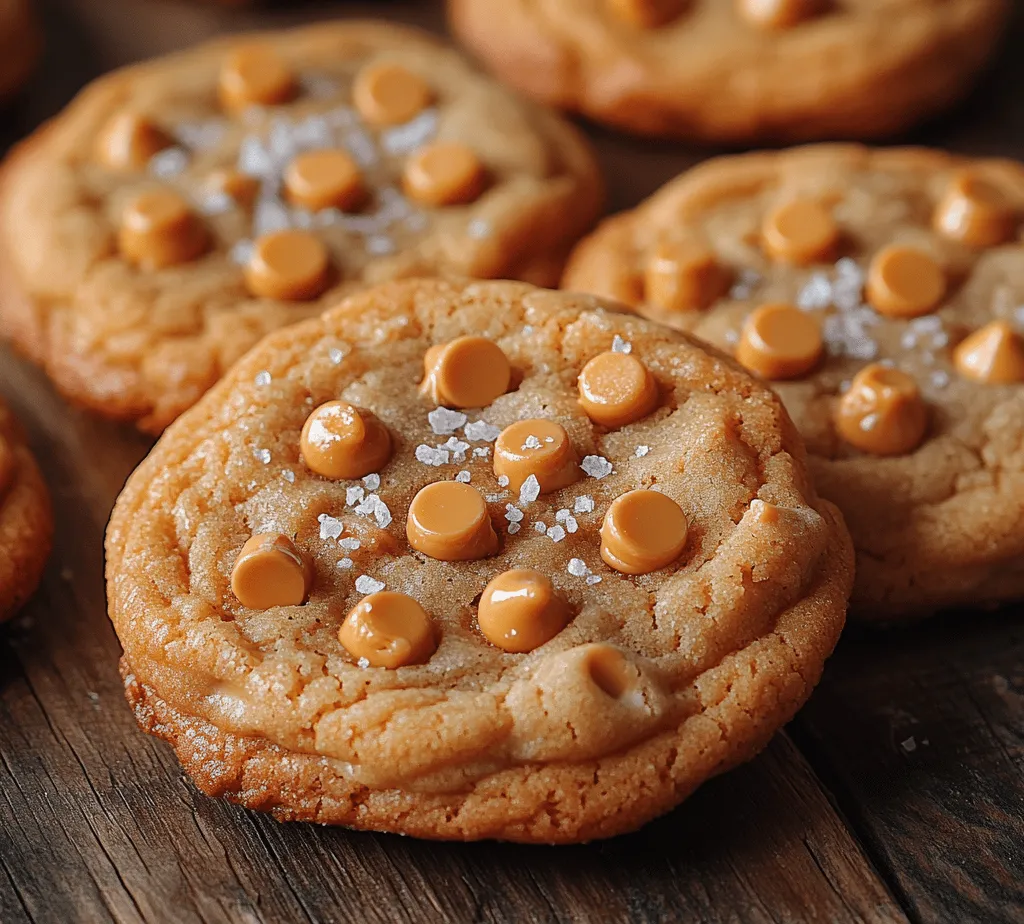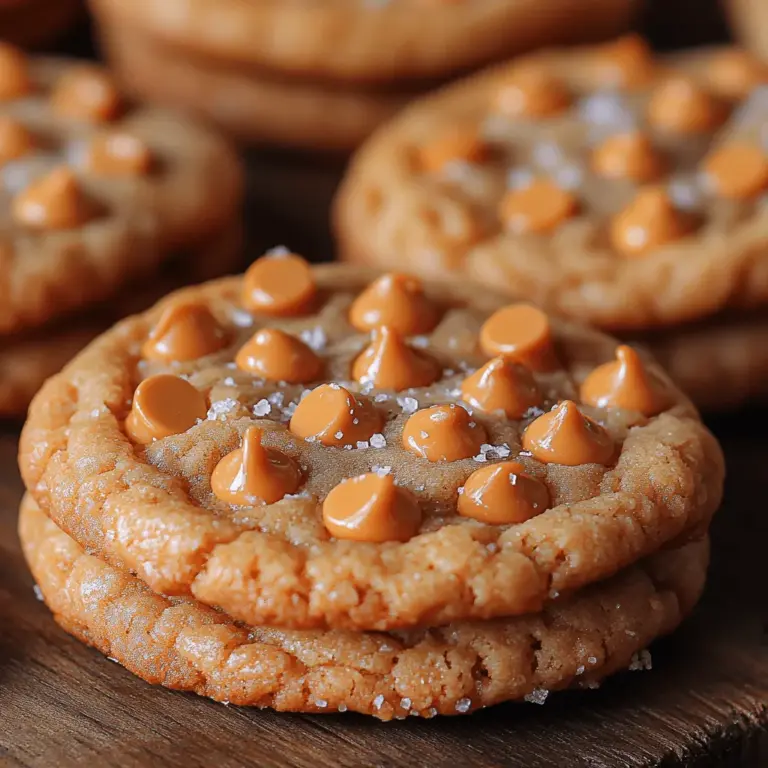Introduction
There’s something undeniably captivating about cookies that draws home bakers into the kitchen. The aroma of freshly baked cookies wafting through the house, the anticipation of that first warm bite, and the satisfaction of sharing a homemade treat with loved ones create a unique and cherished experience. Cookies have a way of evoking comfort and nostalgia, often reminding us of family gatherings, holiday celebrations, or simply cozy afternoons spent with a cup of tea or coffee. Among the myriad of cookie varieties, one stands out for its unique interplay of flavors: the salted butterscotch cookie.
Salted butterscotch cookies offer a delightful twist on the traditional cookie experience, marrying the rich sweetness of butterscotch with a hint of salt that elevates the flavor profile to new heights. This recipe is a perfect representation of the growing trend in baking that celebrates the balance between sweet and salty. The result is a delectable treat that boasts a chewy texture, a rich buttery flavor, and a satisfying crunch from the added sea salt.
What makes these cookies truly irresistible is the harmony of flavors and textures. The deep, caramel-like sweetness of butterscotch chips contrasts beautifully with the subtle salinity of flaky sea salt, creating a mouthwatering experience that keeps you coming back for more. Whether enjoyed as an afternoon snack or served at a gathering, salted butterscotch cookies are sure to impress friends and family alike. In this article, we will guide you through the process of making these delightful cookies, exploring the essential ingredients and providing step-by-step instructions to ensure your baking success.
Understanding the Ingredients
Before diving into the baking process, it’s essential to understand the role of each ingredient in our salted butterscotch cookie recipe. Each component contributes to the overall flavor, texture, and structure of the cookies, ensuring a delightful eating experience. Here’s a detailed examination of the key ingredients that make these cookies so special:
Unsalted Butter
Using softened unsalted butter is crucial for achieving the right texture in your cookies. The butter should be at room temperature, allowing it to cream easily with the sugars. This creaming process incorporates air into the dough, resulting in a light and tender cookie. Unsalted butter is preferred because it gives you complete control over the salt content in your recipe, allowing you to add just the right amount of flaky sea salt later for that perfect sweet and salty balance.
Brown Sugar vs. Granulated Sugar
This recipe uses both brown sugar and granulated sugar, each playing a unique role in the flavor and moisture of the cookies. Brown sugar, which contains molasses, adds a rich, caramel-like flavor and helps keep the cookies moist and chewy. Granulated sugar, on the other hand, contributes to the cookies’ structure and helps achieve a slightly crisp exterior. The combination of these two sugars creates a balanced sweetness that enhances the overall taste of the cookies.
Eggs
Eggs serve multiple purposes in baking. They act as a binding agent, helping to hold the cookie dough together, and they also add moisture, contributing to the overall texture. In this recipe, one large egg is sufficient to provide the necessary structure and richness to the cookies. Make sure the egg is at room temperature for better incorporation into the dough.
Vanilla Extract
Vanilla extract is a staple ingredient in many cookie recipes, and for a good reason. It enhances the overall flavor profile by adding depth and warmth to the cookies. The aromatic qualities of vanilla complement the sweetness of the butterscotch and the richness of the butter, making every bite a little more delightful. Opt for pure vanilla extract for the best flavor, as artificial vanilla can lack the complexity of its natural counterpart.
All-Purpose Flour, Baking Soda, and Salt
These ingredients form the foundation of your cookie dough. All-purpose flour provides the structure necessary for the cookies to hold their shape while baking. Baking soda acts as a leavening agent, contributing to the cookies’ lightness and helping them rise slightly as they bake. Finally, a pinch of salt enhances the overall flavor, balancing the sweetness and highlighting the butterscotch flavor.
Butterscotch Chips
The star of this recipe, butterscotch chips, are what make these cookies truly special. Their rich, buttery flavor melts beautifully during baking, creating pockets of sweetness throughout the cookie. You can find butterscotch chips in most grocery stores, but if you can’t find them, you can always substitute them with chocolate chips for a different yet delicious twist.
Flaky Sea Salt
The finishing touch that elevates these cookies to the next level is flaky sea salt. Sprinkling a small amount of sea salt on top of the cookies just before baking enhances the flavor and provides a delightful contrast to the sweetness of the butterscotch. The crunch of the salt against the chewy cookie creates an irresistible texture that invites you to savor each bite.
Step-by-Step Instructions
Now that we have a solid understanding of the ingredients, it’s time to roll up our sleeves and start baking! Follow these step-by-step instructions to create your very own batch of salted butterscotch cookies.
Preheat the Oven
Before beginning any baking project, it’s essential to preheat your oven to ensure that it reaches the correct baking temperature. For these salted butterscotch cookies, set your oven to 350°F (175°C). Preheating your oven is crucial because it allows for even baking, resulting in cookies that are perfectly golden brown on the outside and chewy on the inside.
Creaming Butter and Sugars
In a large mixing bowl, combine 1 cup of softened unsalted butter, 3/4 cup of brown sugar, and 1/2 cup of granulated sugar. Using an electric mixer or a sturdy wooden spoon, cream the butter and sugars together on medium speed until the mixture becomes light and fluffy. This process usually takes about 2-3 minutes. Proper creaming is essential as it incorporates air into the batter, which will help the cookies rise while baking.
Incorporating Eggs and Vanilla
Once the butter and sugars are well-creamed, add in 1 large egg and 1 tablespoon of pure vanilla extract. Mix until just combined. Be careful not to overmix at this stage, as this can lead to tougher cookies. The goal is to achieve a homogenous mixture where the egg and vanilla are fully incorporated into the butter-sugar mixture.
Combining Dry Ingredients
In a separate bowl, whisk together 2 cups of all-purpose flour, 1 teaspoon of baking soda, and 1/2 teaspoon of salt. Gradually add the dry ingredients to the wet mixture, mixing on low speed or with a spatula until just combined. It’s important to avoid overmixing at this stage; overworking the dough can lead to dense and tough cookies. Stop mixing as soon as no streaks of flour remain in the dough.
Folding in Butterscotch Chips
Now it’s time to add the star ingredient—1 cup of butterscotch chips. Using a spatula, gently fold the butterscotch chips into the cookie dough, ensuring they are evenly distributed throughout. This step is crucial for achieving that delightful burst of sweetness in every cookie.
Shaping the Cookies
Using a cookie scoop or a tablespoon, portion out the cookie dough onto a baking sheet lined with parchment paper. Make sure to leave enough space between each cookie, as they will spread while baking. A good rule of thumb is to leave about 2 inches of space between each dough ball. For an even bake, try to shape the dough into uniform balls, which will help them cook evenly.
With these steps completed, you are well on your way to baking a delicious batch of salted butterscotch cookies that will have everyone coming back for seconds. The next part of this recipe will cover the baking process and some helpful tips for achieving the best results. Stay tuned as we continue this delicious journey into cookie-making bliss!

Adding Flaky Sea Salt
One of the most delightful aspects of salted butterscotch cookies is the finishing touch of flaky sea salt. This simple yet sophisticated addition not only enhances the overall flavor profile but also elevates the presentation of the cookies. When you sprinkle flaky sea salt on top of the warm, freshly baked cookies, it creates a contrast that tantalizes the taste buds. The saltiness cuts through the sweetness of the butterscotch, balancing the flavors perfectly.
From a presentation standpoint, the glistening flakes of salt against the rich golden-brown surface of the cookies provide a visually appealing contrast that makes these treats irresistible. For the best results, add the flaky sea salt immediately after taking the cookies out of the oven when they are still warm, allowing the salt to slightly adhere to the surface. This simple step transforms your cookies from ordinary to extraordinary, making them a standout treat for any occasion.
Baking Process
Baking these salted butterscotch cookies requires careful attention to time and temperature to ensure the perfect texture. Preheat your oven to 350°F (175°C), as this is the ideal temperature for baking cookies. When you place your cookie dough balls on the baking sheet, leave enough space between them to allow for spreading.
The ideal baking time for these cookies is between 10 to 12 minutes. Keep a close eye on them as they bake; you’ll know they’re done when the edges are golden brown while the centers still appear slightly underbaked. This is a key indicator that the cookies will continue to firm up as they cool, resulting in a chewy center that complements the crisp edges. Overbaking can lead to dry cookies, so trust your instincts and remove them from the oven when they still look a bit soft in the middle.
Cooling Techniques
Cooling your cookies properly is crucial for achieving the desired texture. Once you remove the cookies from the oven, let them sit on the baking sheet for about 5 minutes. This allows them to set and firm up slightly before transferring them to a wire rack. The wire rack is essential for cooling because it allows air to circulate around the cookies, preventing them from becoming soggy on the bottom.
Cooling cookies on a wire rack also helps maintain their distinct textures—keeping the edges crisp while ensuring the centers remain chewy. If you’re feeling adventurous, you might consider drizzling a little extra butterscotch sauce over the cookies right before serving for an added touch of indulgence.
Serving Suggestions
Salted butterscotch cookies are incredibly versatile and pair beautifully with various accompaniments. For a classic treat, serve them with a tall glass of cold milk—there’s something inherently nostalgic about this pairing. You can also elevate your cookie experience by serving them alongside a scoop of vanilla ice cream, creating a delightful cookie à la mode.
For a more sophisticated touch, consider pairing your cookies with a rich cup of coffee or a robust tea. The bitterness of coffee complements the sweetness of the butterscotch, while a floral tea can enhance the overall flavor experience. If you’re hosting a gathering, arrange them on a platter with some fresh fruit, like sliced strawberries or figs, for a colorful and inviting display.
The Science of Baking Cookies
Baking cookies is as much a science as it is an art, with each ingredient playing a vital role in the final product.
Butter is the star, providing richness and flavor. The fat in butter contributes to the tenderness of the cookies, while the sugar aids in caramelization and browning.
Sugars play an essential role in texture and sweetness. Brown sugar, which is used in this recipe, contains molasses, adding moisture and a deeper flavor.
Flour provides structure, and the type of flour can significantly impact the texture of your cookies. All-purpose flour is commonly used for its balance of protein and starch, but experimenting with whole wheat or alternative flours can yield different results.
The Maillard reaction is a crucial process that occurs during baking, leading to the golden edges and the development of complex flavors. This reaction takes place when sugars and amino acids react under heat, creating that delightful golden-brown crust that we all love.
Maintaining the right oven temperature is critical for all these reactions to happen properly. Too hot, and your cookies may burn before they have time to rise; too cool, and they may spread too much and become flat.
Healthier Alternatives and Variations
For those looking to make a healthier version of these salted butterscotch cookies, there are several substitutions you can consider.
– Sugars: Instead of granulated and brown sugar, try using organic cane sugar or coconut sugar, which has a lower glycemic index. These options can reduce sugar spikes while still providing sweetness.
– Fats: Instead of butter, you can use coconut oil or unsweetened applesauce. Coconut oil will impart a subtle coconut flavor, while applesauce will create a softer cookie.
– Flours: If you’re looking to increase the nutritional value, try using whole wheat flour or almond flour in place of all-purpose flour. Both options add fiber and protein, resulting in a denser cookie.
To elevate the texture and flavor even further, consider adding chopped nuts like pecans or walnuts, or mix in dried fruits such as cranberries or cherries. These additions not only provide an interesting contrast to the soft cookie but also enhance the nutritional profile.
If you want to switch things up entirely, try incorporating chocolate chips or peanut butter into your cookie batter for unique flavor variations. Each adjustment opens up a world of possibilities, allowing you to customize your salted butterscotch cookies to your preference.
The Joy of Baking Cookies
Baking cookies is more than just a culinary task; it is an emotional and social experience that brings people together. The aroma of freshly baked cookies wafting through the house is a comforting scent that evokes nostalgia and warmth. Many families have traditions centered around cookie baking, whether for holidays, birthdays, or simply as a way to spend time together.
Sharing cookies with friends and family can create lasting memories. The act of baking together fosters connection, laughter, and love. Whether you are hosting a gathering, surprising a neighbor, or simply indulging in a sweet treat yourself, cookies have a unique way of spreading joy.
Around the world, different cultures celebrate the art of cookie baking in their own ways. From Italian biscotti to German lebkuchen, cookies are often synonymous with festivities and celebrations. Each culture brings its flavors and techniques, creating a rich tapestry of cookie traditions.
Conclusion
In conclusion, the unique taste and texture of salted butterscotch cookies provide a delightful culinary experience that is both satisfying to bake and enjoyable to share. The combination of sweet butterscotch and flaky sea salt creates a flavor profile that is truly irresistible.
Whether you’re baking for yourself, your family, or a special occasion, the joy of creating these cookies is unparalleled. The process of mixing, baking, and finally indulging in your homemade treats is a rewarding journey that offers not just delicious results but also cherished moments.
So gather your ingredients, preheat your oven, and embark on the delightful adventure of baking salted butterscotch cookies. Enjoy the process, savor the flavors, and share the love!


